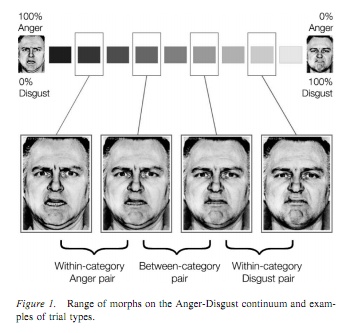A new paper in the journal ‘Emotion’ has presented research which has implications for the evolution of language, emotion and for theories of linguistic relativity. The paper, entitled ‘Categorical Perception of Emotional Facial Expressions Does Not Require Lexical Categories’, looks at whether our perception of other people’s emotions depend on the language we speak or if it is universal. The results come from the Max Planck Institute for Psycholinguistics and Evolutionary Anthropology.
Human’s facial expressions are perceived categorically and this has lead to hypotheses that this is caused by linguistic mechanisms.
The paper presents a study which compared German speakers to native speakers of Yucatec Maya, which is a language which has no labels which distinguish disgust from anger. This was backed up by a free naming task in which speakers of German, but not Yucatec Maya, made lexical distinctions between disgust and anger.
The study comprised of a match-to-sample task of facial expressions, and both speakers of German and Yucatec Maya perceived emotional facial expressions of disgust and anger, and other emotions, categorically. This effect was shown to be just as significant across the language groups, as well as across emotion continua (see figure 1.) regardless of lexical distinctions.
The results show that the perception of emotional signals is not the result of linguistic mechanisms which create different lexical labels but instead shows evidence that emotions are subject to their own biologically evolved mechanisms. Sorry Whorfians!
References
Sauter DA, Leguen O, & Haun DB (2011). Categorical perception of emotional facial expressions does not require lexical categories. Emotion (Washington, D.C.) PMID: 22004379



Just as an aside, does anyone else think that the picture of the angry man looks like Richard Dawkins?
Haha, it’s like Dawkins is transforming into the Hulk: “BIBLES MAKE DAWKINS ANGRY. SMASH CATHEDRALS. SMASH CHOIR CHILDREN. SMASH ABSTRACT ENTITIES FOR WHICH THERE IS NO EMPIRICAL EVIDENCE!”
As far as I can see, the only thing the experiment is testing is perception of facial expressions. The connection between these facial expressions and emotion is being assumed, not demonstrated. (I suspect Mayans and Germans do interpret them similarly, but this paper doesn’t tell me one way or the other.)
But the perception of facial expressions and the perception of emotion are the same thing… aren’t they? That’s how humans perceive emotion for the most part? I think it’s pretty safe to be assumed and not demonstrated, given that that’s not what the paper was trying to demonstrate, presumably because the connection is already so established.
I agree with Lameen, I’m doing a critique on this paper and I felt that a distinction between identifying and interpretation should be made.